I used to think Dun Laoghaire in Ireland was pronounced 'dun leg hair', but in fact, you say it 'dun leery'. And that's where I went this weekend for Mountains to Sea Book Festival, along with a gorgeous gaggle of other writers, illustrators and book people, including this gang here: Oxford Story Museum's Tom Donegan, writer Judi Curtin, fellow space cadet and co-author Philip Reeve and writer Steve Cole: 
But I'm so madly busy working on Pugs of the Frozen North right now (my upcoming book with Philip Reeve), that Philip kindly offered to do the blogging for me! So pop over to his blog for ALL OF THE NEWS: 
***Keep reading Philip's blog here!***
Huge thanks to organiser and writer Sarah Webb for making everything go so smoothly! Also, big thanks to Oxfordshire Book Awards for making There's a Shark in the Bath your runner-up winner in the Picture Book category. Fab! 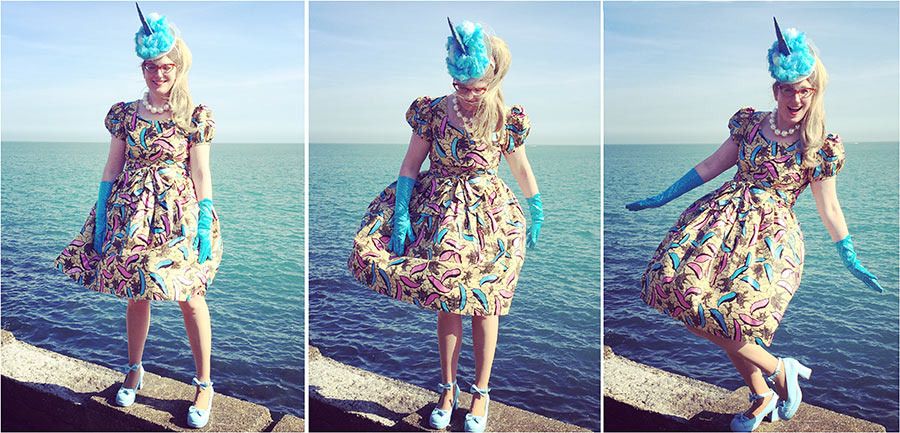
One more thing, journalist Fiona Noble in The Bookseller magazine just featured Pugs of the Frozen North as one of her top books to watch out for. Thanks, Fiona!
Viewing: Blog Posts Tagged with: Dublin, Most Recent at Top [Help]
Results 1 - 13 of 13
Blog: Sarah McIntyre (Login to Add to MyJacketFlap)
JacketFlap tags: ireland, festivals, cole, dublin, reeve, cakes_in_space, Add a tag
Blog: OUPblog (Login to Add to MyJacketFlap)
JacketFlap tags: Literature, joyce, ireland, OWC, ulysses, james joyce, Oxford World's Classics, Dublin, Irish Literature, bloomsday, Humanities, *Featured, the dubliners, a portrait of the artist as a young man, finn fordham, Finnegans Wake, Add a tag

By Finn Fordham
Joyce was obsessed with birthdays. Today, February 2nd, is his. An emerging secular saint’s day, it will be remembered and alluded to round the world – especially in Dublin — in the corners of newspapers and pubs, in blogs (like this one), tweets and the odd talk. Born in 1882, Joyce’s cake — if he could have one, let alone eat it — would have a hundred and thirty one candles; a hundred years ago, therefore, he would have been celebrating his 31st birthday. The image of candles is suitable, since Joyce’s birthday fell on ‘Candlemas’, a holy day which commemorates Christ’s first appearance in a synagogue with his mother, forty days after his birth, in part by the lighting of candles. Mary was following the Mosaic law which says that, after giving birth, a mother is not clean for forty days, at which point she is to be purified through sacrifice.
‘Celebrating’, however, might be too strong a word: in 1913, Joyce was, artistically, in something of a lull, and life might well have been frustrating. He was teaching English in Trieste, with two small children, aged 5 and 7. He was struggling to get Dubliners past timid publishers and printers; A Portrait…, begun some nine years before, was unfinished; Ulysses was not yet begun. He was writing the odd bit of journalism, but the high artistic ambitions he had cherished as a young man had taken a battering. He’d spent his twenty-first in Paris, receiving a letter written by his father John Joyce, which he would carefully keep wherever he went:
My dear Jim, May I be permitted to offer you my best wishes for your future which I, at one time, fancied may have been more rosey on your attaining your majority [i.e becoming 21]… I hope you will beleive [sic] me that I am only now, under I may tell you, very trying times, endeavouring to do my little best, but Jim you are my eldest Son I have always looked up to your being a fitting representative of our family one that my father would be proud of. I now only hope that you may carry out his ideas through your life and if you do, you may be sure you will not do anything unbecoming a gentleman.
John Joyce, here and in general, was, like Simon Dedalus in Ulysses, strong and open in his expression of emotion. He is not the stereotypical cold and detached Victorian father. On the other hand, the complexity of his warmth borders on ambiguity, and its intensity must have brought some pressure to the young and, by all accounts, lonely Joyce: the father feels responsible for failing his son, but implies that his son was failing, or in danger of doing so; he seeks forgiveness while sending his son on a guilt trip; he says he looks up to him, while also establishing a role model in his own father, thus reaffirming the patriarchal hierarchy of genealogy. Self-pityingly unable to help materially, he adopts the role of civic mentor — urging him to behave like a gentleman, as Polonius did to Laertes when the latter was about to go to Paris (and its fleshpots). Larkin’s term for such ambivalence was ‘sloppy-stern’.
 Birthdays may be a universal convention, but they are not universally liked. One pressure that birthdays bring is the inevitability, almost the duty, of self-reflection — a pressure which the Joyces, father and son, must have been aware of in 1903. The attention of others — fathers, mothers, friends, colleagues, wishing us well, presenting a gift, raising a glass — may exacerbate processes of self-examination and even pernicious comparison. Relative to where we were, or where we hoped to be, relative to our peers, or where our role models once were — where have we got to, or to what have we sunk? Birthdays are ciphers that multiply whatever condition we’re in. The potential trauma of birthdays repeats, perhaps compulsively, the trauma of the day of birth. The twitching nervous checking during labour of the condition of mother and child – how are they doing, what are their heart rates? — becomes a twitching nervous checking on birthdays of whether one has yet become oneself.
Birthdays may be a universal convention, but they are not universally liked. One pressure that birthdays bring is the inevitability, almost the duty, of self-reflection — a pressure which the Joyces, father and son, must have been aware of in 1903. The attention of others — fathers, mothers, friends, colleagues, wishing us well, presenting a gift, raising a glass — may exacerbate processes of self-examination and even pernicious comparison. Relative to where we were, or where we hoped to be, relative to our peers, or where our role models once were — where have we got to, or to what have we sunk? Birthdays are ciphers that multiply whatever condition we’re in. The potential trauma of birthdays repeats, perhaps compulsively, the trauma of the day of birth. The twitching nervous checking during labour of the condition of mother and child – how are they doing, what are their heart rates? — becomes a twitching nervous checking on birthdays of whether one has yet become oneself.
For an ambitious person, for someone intent on establishing a mythology of themselves, for someone superstitious, birthdays, especially their own, and other anniversaries are crucial. And so they were for Joyce, for these very reasons. He habitually made awkward deadlines for himself and his publishers, by wanting his books to appear on his birthday or, failing that, his father’s. The day on which Ulysses is set (itself the day of the troubled birth, though fictional, of Mortimer Edward Purefoy), is supposed to be the day of Joyce’s first date with Nora Barnacle, though their encounter is not in fact recorded in the fiction.
Through the cyclical repetition of dates, days become haunted, charged with the meaning of the events of the past, implicit in their dates: Armistice Day, Guy Fawkes, the Battle of the Boyne. The different calendars of the global village, now shared in multi-cultural societies, show the space of the year as an environment that is densely built up with official anniversaries which are the signs and the foundations of institutions, of nations, states, religions, organisations, movements.
Anniversaries seem inevitable because of the cycle of the year, but they are not guaranteed: different anniversaries can coincide on the same day, so that one feast day ousts another; secular festivals push out saints’ days. Joyce cheekily engineered such a coincidence in the birthday of Molly Bloom, which was September the 8th, the same day as the Virgin Mary’s birthday. Joyce’s love of birthdays is in part a wish to appropriate this map, a symptom of an eternal struggle he identified between the individual and society: ‘the state is concentric; man is concentric. Thence arise an eternal struggle.’
We have a Bloomsday, on which the institution of Joyce studies (and Joycolatry) are built. But there is no Wake-day: Finnegans Wake does not seem to happen on a single day, though for one critic it is a dream dreamt on 28 March 1938. For others the events of the Wake happen everyday and anyday. Unlike Ulysses, it has not been so easily institutionalised. Either way, it is certainly worth celebrating and lighting candles for: and Joyce’s birthday is as good as any to do so.
Dr Finn Fordham is Reader in 20th Century Literature at Royal Holloway, University of London. Along with Robbert-Jan Henkes and Erik Bindervoet, he has edited the Oxford World’s Classics edition of Finnegans Wake by James Joyce. Finnegans Wake is a book that reinvents the novel and plays fantastic games with the language to tell the story of one man’s fall and resurrection; in the intimate drama of Humphrey Chimpden Earwicker and his wife Anna Livia, the character of Ireland itself takes form. Joyce called time and the river and the mountains the real heroes of his book, and its organic structure and extraordinary musicality embody his vision. It is both an outrageous epic and a wildly inventive comedy that rewards its readers with never-ending layers of meaning.
For over 100 years Oxford World’s Classics has made available the broadest spectrum of literature from around the globe. Each affordable volume reflects Oxford’s commitment to scholarship, providing the most accurate text plus a wealth of other valuable features, including expert introductions by leading authorities, voluminous notes to clarify the text, up-to-date bibliographies for further study, and much more. You can follow Oxford World’s Classics onTwitter and Facebook.
Subscribe to the OUPblog via email or RSS.
Subscribe to only literature articles on the OUPblog via email or RSS.
Image credit: By Paweł Cieśla Staszek_Szybki_Jest (Own work) [CC-BY-SA-3.0-2.5-2.0-1.0], via Wikimedia Commons
The post James Joyce and birthdays appeared first on OUPblog.
Blog: OUPblog (Login to Add to MyJacketFlap)
JacketFlap tags: *Featured, abbey theatre, ann saddlemyer, Theatre & Dance, Arts & Leisure, j m synge, john millington synge, the playboy of the western world, the playboy riots, History, Literature, yeats, drama, ireland, OWC, playboy, Europe, Oxford World's Classics, Dublin, Irish Literature, Humanities, Add a tag

By Ann Saddlemyer
There had been rumours for months. When Dublin’s Abbey Theatre announced that John Millington Synge’s new play The Playboy of the Western World would be produced on Saturday, 26 January 1907, all were on alert. Controversy had followed Synge since the production of his first Wicklow play, The Shadow of the Glen, in which a bold, young, and lonely woman leaves a loveless May/December marriage to go off with a fine-talking Tramp who rhapsodizes over the freedom of the roads. Irish women wouldn’t do that!
In The Playboy the action takes place in a public house on the wild coast of Mayo, when a travel-stained stranger enters and is persuaded to tell his story. Impressed, the admiring on-stage audience thinks he must be very brave indeed to have killed his father, and in turn the young tramp blossoms into the daring rollicking hero they believe him to be – winning all the prizes at the races and the love of the publican’s daughter. But then his father, with a bandaged head, turns up seeking his worthless son who is not the courageous father-slayer after all. Disillusioned and angry at the loss of their hero, the onstage crowd turns brutally on Christy, who tries to prove that he is indeed capable of savage deeds, even attempting unsuccessfully to kill his father a third time. The play ends with father and son leaving together, dismissing the onstage audience with the words “Shut yer yelling for if you’re after making a mighty man of me this day by the power of a lie, you’re setting me now to think if it’s a poor thing to be lonesome, it’s worse maybe to go mixing with the fools of earth”.

Irish actors Sara Allgood (“Pegeen Mike”) and J. M. Kerrigan (“Shawn Keogh”), in ‘The Playboy of the Western World’, Plymouth Theatre, Boston, 1911.
Yet the playwright does not seem to have been aware of the response his play would cause, insisting that it was merely a comedy, an “extravaganza”, meant to entertain, and that “the story — in its ESSENCE — is probable, given the psychic state of the locality.” Not to this audience, who charged him with immorality, obscenity and blasphemy, “a sordid, squalid and repulsive picture of Irish life and character”, making a hero of “a foul-mouthed scoundrel and parricide”.
For three years Synge had painstakingly developed his original idea, producing more than a thousand typescript pages, drafts and scenarios, all the way to draft “K” before he finally hit on the brilliantly ambiguous final form. For a “playboy” may be an athlete, performer, seducer, trickster, manipulator, creator, hero, or all of the above; while “the western world” might refer to County Mayo, to the United States, or to this world as contrasted with that “eastern world” of folk and fairy tales — or to all. “What a blessing you did not go to version L, if Version K had such a disastrous effect!” a friend commented in the turbulent months that followed.
Like Christy’s own tale of slaying his Da, the story of his injuries to Ireland’s good name continued to grow with the years. When the Abbey theatre took the play on tour to the United States, the clash between the idea of a pure nationhood cherished by Irish immigrants and what they saw on stage was even more pronounced. In New York missiles were thrown on the stage, and a hundred police attempted to keep order. Lady Gregory, who led the tour, received death threats; Theodore Roosevelt’s presence at the second performance ensured a more sedate reception. But when the company arrived in Philadelphia all hell broke loose, and the players were hauled into court by an Irish-American patriot who accused the company and the play of indecency. The case was dismissed when the judge learned that the accusers had not read the text.
In the theatre individual response to what is clearly not real can quickly become an excuse for objecting to what is perceived to be real. Audiences have always felt justified in expressing their disapproval of what is staged, or attempted to be staged. In 18th century London theatre managers petitioned the King for a guard of soldiers; one manager engaged thirty prize-fighters as well. Destruction of scenery, benches and even musical instruments was all too common when the audience felt cheated; often foreign performers were pelted with rotten fruit and other missiles (and told to go home).
Patriotism was perhaps the most frequent cause, especially in Ireland where the stage Irishman, created by English dramatists, was a subject of mockery and ridicule, and where class, nationalism, and religion were inextricably entwined. In 1907 however the disturbance was premeditated, with members of the audience carrying in stink bombs, rotten vegetables, trumpets, whistles, and other paraphernalia. There was clearly an organized cabal determined to silence a work which is now considered a masterpiece of comedy, performed throughout the world and recently the centrepiece of a world tour.
Would such events happen today? We are much more accustomed to onstage violence; but censorship is still very much with us. Synge suggests that to hold a dream is better than to live with caution; the outsider serves to perpetuate the myth-making process while at the same time challenging it, introducing a heightened self-awareness which embraces community on both sides of the footlights. Thus the audience is caught off-guard, encouraged to enter the world of fantasy, then betrayed by a reality of a different sort — the dream itself can threaten if fulfilled; we are briefly dangled above two worlds at once.
Ann Saddlemyer has published extensively on Irish and Canadian theatre and edited the plays of Lady Gregory and the letters between the founding Directors of the Abbey Theatre. Her book Becoming George: The Life of Mrs W.B. Yeats was shortlisted for the James Tait Black Memorial Prize for Biography. She has most recently edited W.B. Yeats and George Yeats: The Letters. She is the editor of the Oxford World’s Classics edition of Synge’s The Playboy of the Western World and Other Plays.
For over 100 years Oxford World’s Classics has made available the broadest spectrum of literature from around the globe. Each affordable volume reflects Oxford’s commitment to scholarship, providing the most accurate text plus a wealth of other valuable features, including expert introductions by leading authorities, voluminous notes to clarify the text, up-to-date bibliographies for further study, and much more. You can follow Oxford World’s Classics on Twitter and Facebook.
Subscribe to the OUPblog via email or RSS.
Subscribe to only literature articles on the OUPblog via email or RSS.
Image credit: From the Isabella Stewart Gardner Museum Archive, Boston [Public domain], via Wikimedia Commons
The post The Playboy Riots of 1907 appeared first on OUPblog.
Blog: Sarah McIntyre (Login to Add to MyJacketFlap)
JacketFlap tags: ireland, festivals, dublin, reeve, Add a tag
So here are the top superheroes behind one of the best book festivals I've ever been to! Meet Tom Donegan and Sarah Webb, Ireland's ultimate dream team: 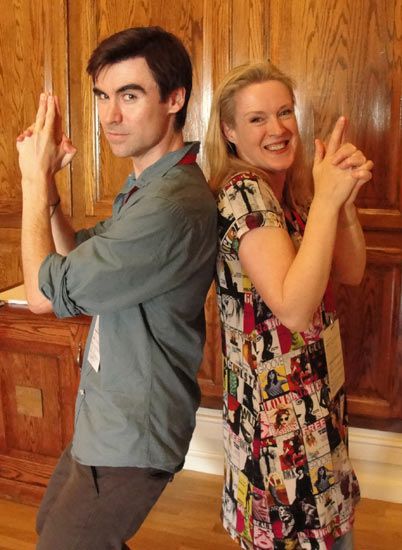
The sun was shining bright and Dun Laoghaire (pronounced 'dun LEER-y'), just next to Dublin, felt like being on the Mediterranean riviera. And I got to hang out with one of my best friends, writer Philip Reeve! We strolled along the promenade with Irish filmmaker Frank Kelly, who kindly agreed to take this author photo for the book I'm working on with Philip right now, Oliver and the Seawigs. My studio mate, Gary, just looked over my shoulder and said I look like a mermaid, so that's perfect. 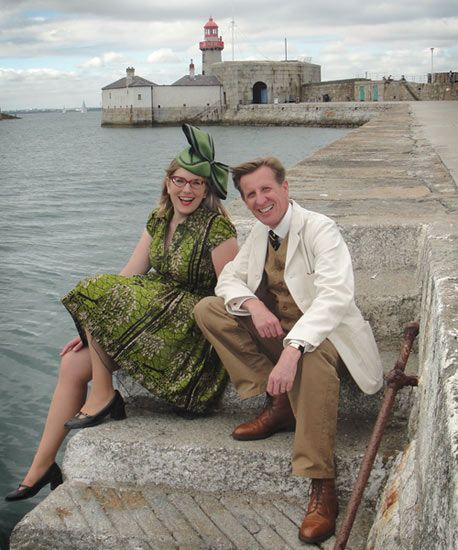
On the first evening, Tom and Sarah took me for dinner with Philip, writer Marcus Sedgwick and top librarian Dr Marian Thérèse Keyes, who took the photo. 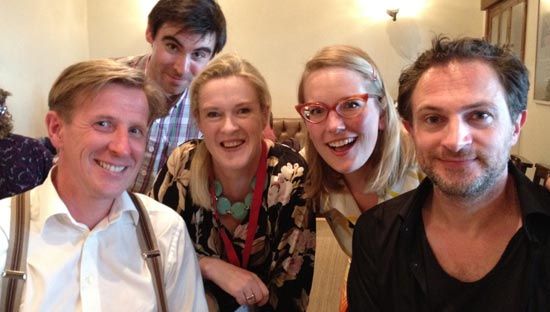
After dinner, Marcus, Philip and I went along to hear Sarah Webb talk about her book and writing, along with lots of other writers for adults and young adults, including Cathy Kelly, Katie Fforde, Vanessa Fox O’Loughlin, Sinéad Moriarty and Marita Conlon-McKenna. Our dinner had run overtime a bit, so we were sitting way, way in the back and couldn't see all that much. The panel gave a great talk, but the three of us were quite jolly from dinner and I made stupid drawings of us.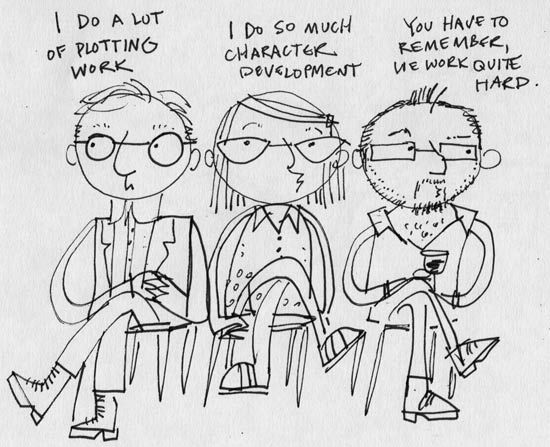
The next morning, Philip and I did a big MONSTERS & GOBLINS stage event, in front of something like 300 kids. It was loads of fun! Here's Philip with a miniature version of a bratapult, a weapon of war which plays quite a key part in his Goblins book. In fact, his main character spends something like two chapters falling after being hurtled from such a device. We fired goblins into the audience to make some merry chaos.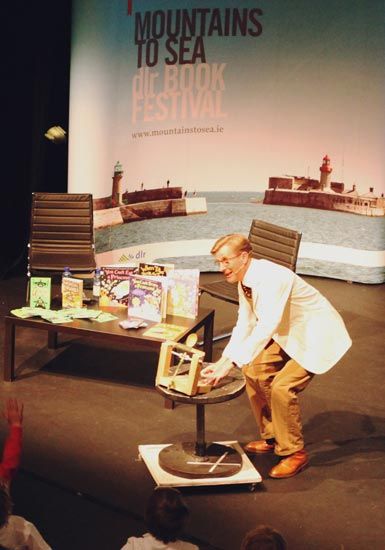
At two different events, we introduced ourselves while the other person drew an attractive portrait. We weren't allowed to look at our portrait until it was finished. You can get a glimpse over my shoulder here of Philip's drawing of me, which set the kids in the audience absolutely howling. 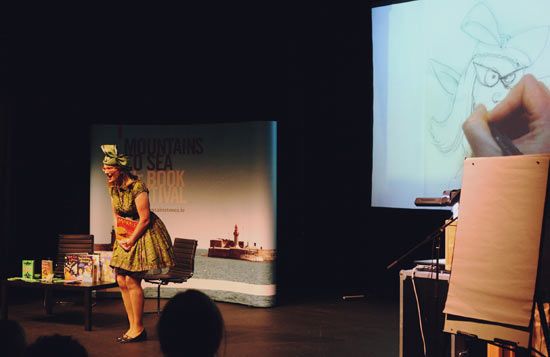
I grossed out the kids with a reading from Morris the Mankiest Monster and then the kids helped us invent new monsters, and Philip and I took turns drawing how we thought some of the characters in Goblins might look, including Trolls and Boglins. Here's Philip's Boglin. 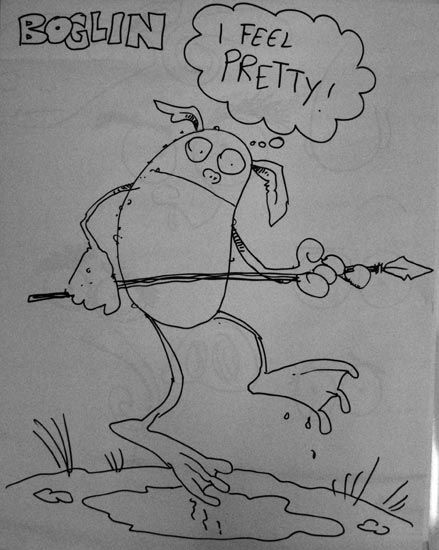
Then we turned the kids into a tribe of goblins by having them each design a goblin face. 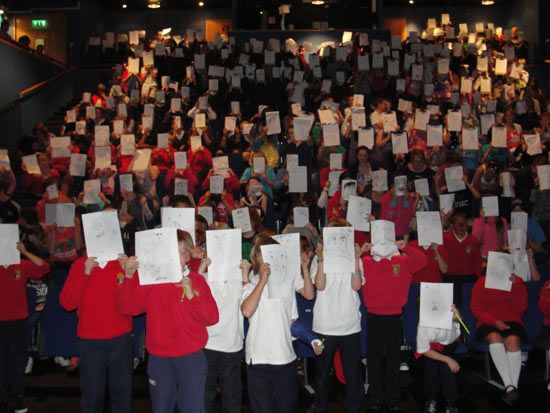
It was fun seeing the kids' work when they came up to get their books signed. 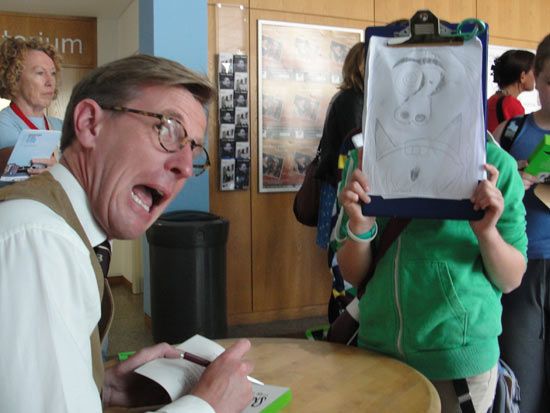
Hee hee! 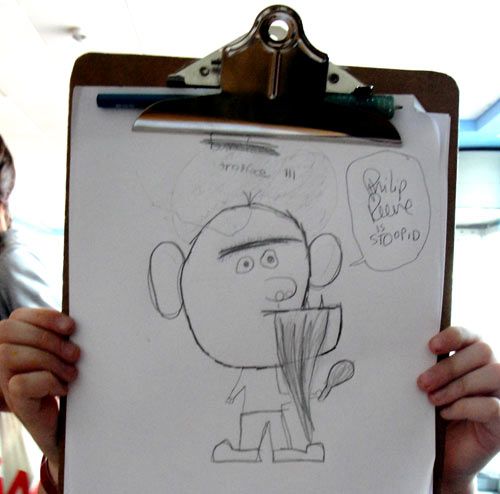
As ever, I can't post photos of the schoolchildren's faces, which is a shame, but they look quite nice with books for heads. 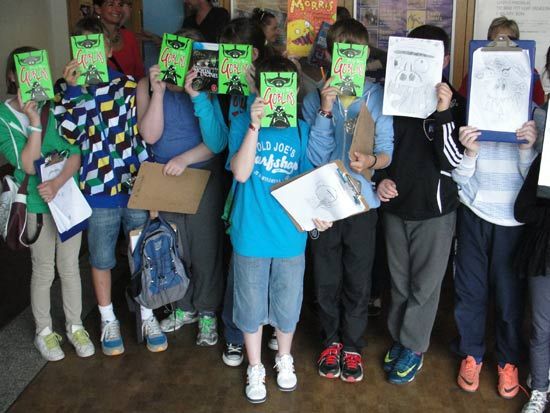
After the show, we recorded an interview for national television, RTE2's Elev8 programme (the same show Gary Northfield and I took part in a couple years ago, which you can see here). It'll go live in the show's next season, probably some time in October. Here are camera crew Elaine Buckley, Julian Hills and Orla Morris-Toolen. 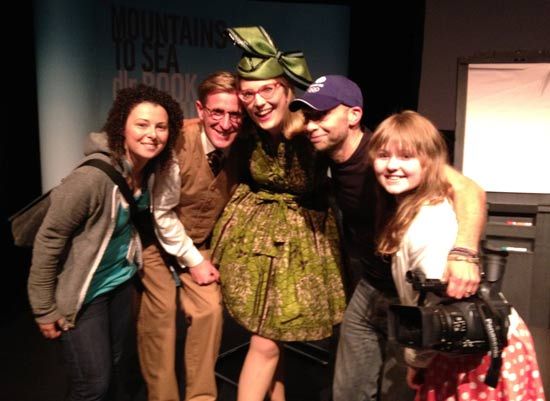
Orla (in the polka-dot dress) was an amazing interviewer; the camera crew would ask her to do something a bit different, and she'd quickly think about it and come up with a good way to ask us a question that fitted in well with the flow of the programme. Not many kids can think on their feet as calmly as that, I was really impressed.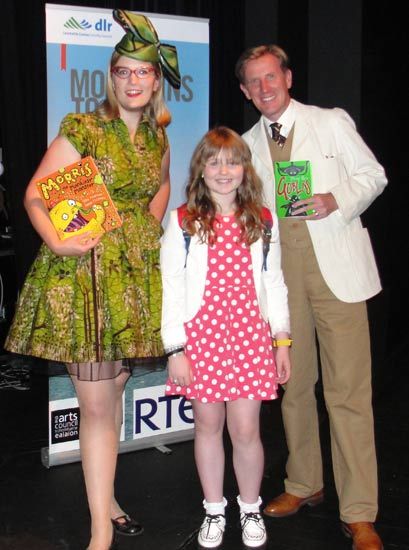
Later on in the festival, I ran into Moldovan Elev8 presenter Diana Bunici, who'd interviewed Gary and me last time. You can follow her on Twitter as @DeeBTweets and read her blog here. 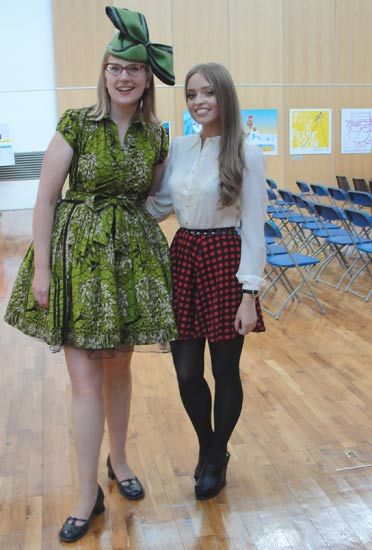
And here's the fabulous illustration exhibition Tom Donegan put together in the County Hall! Scholastic UK let the festival have sneak peeks at two spreads in my new book, Superkid with Claire Freedman, coming out next spring. Here they are, printed up large: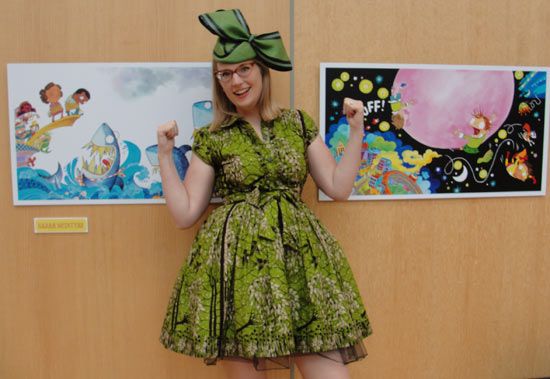
Both times Philip and I had some time off, we took the chance to stroll along the beautiful Dun Laoghaire harbour. Philip took a photo of me in front of this big sea urchin sculpture and said I looked like something painted on the front of a B-52, the thought of which pleases me to no end.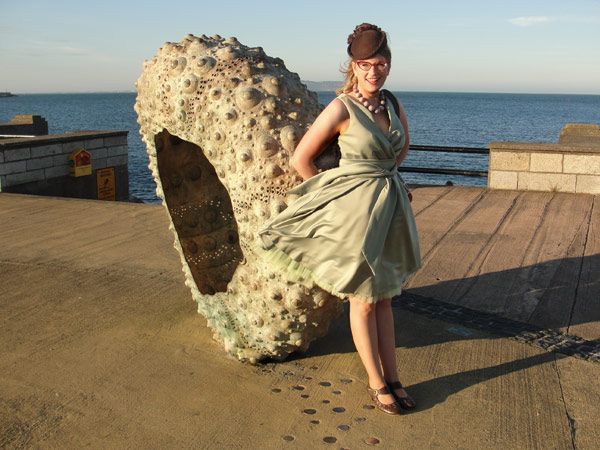
You can just about see the James Joyce Tower in the background. I really should know what this is. *Makes note to self to try to get into Ulysses again, despite several failed attempts*
And here's some of the jolly gang from Children's Books Ireland! Mags Walsh, Jenny Murray (and Aoife (pronounced 'EEF-ah') Murray arrived a bit later); bookseller and blogger Kim Harte, can someone remind me who that nice gentleman is?, and Tom. 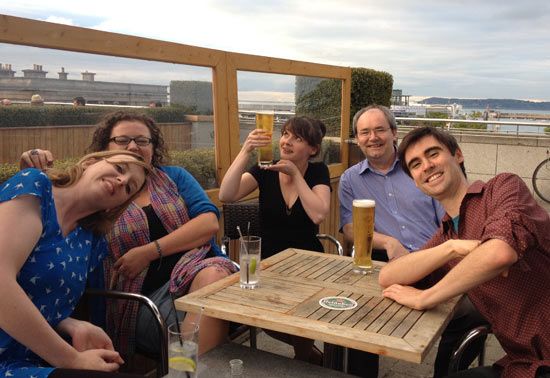
The next day, Philip and I led a Comics Jam workshop in the lovely posh yacht club, with about 20 kids. 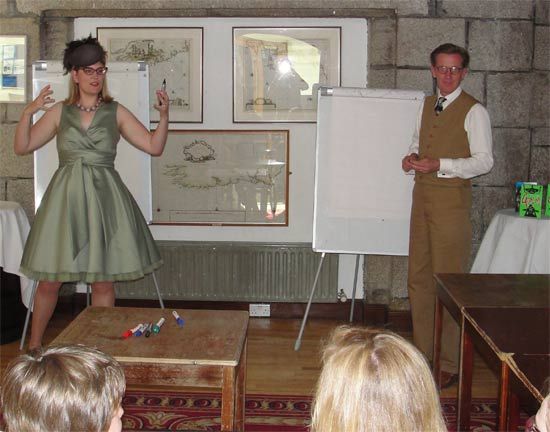
We started out by talking about character design. Here's one Philip drew: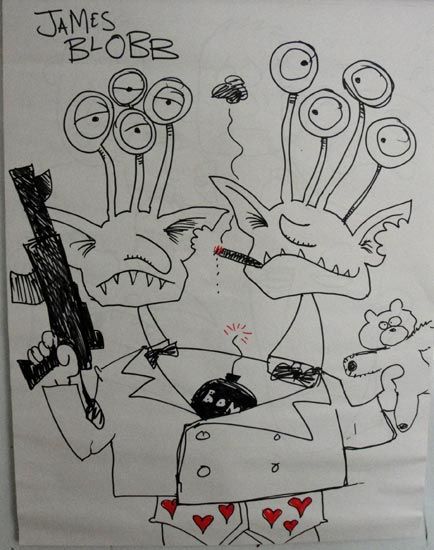
And a kid's drawing. Isn't it fabulous?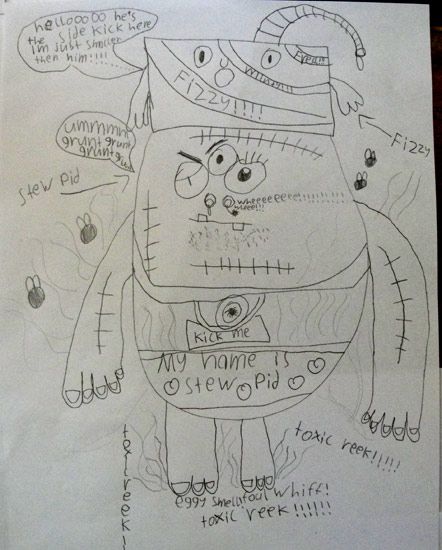
Then we took our characters and put them into a comics story. Here's one Philip and I bashed out at great speed, taking turns with each panel, with story material based on suggestions from the kids. 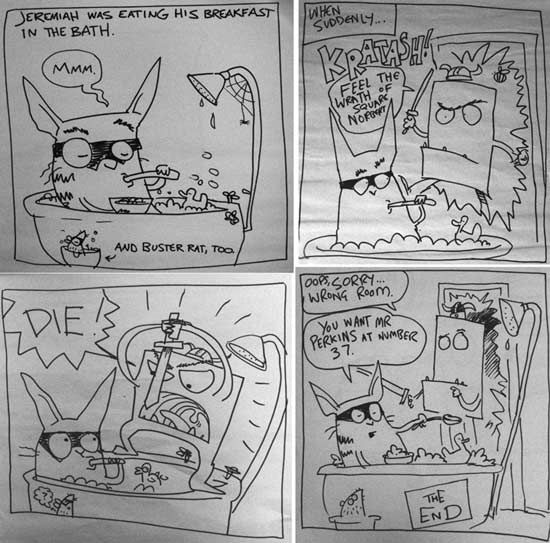
Then we set the kids off on their Comics Jam! 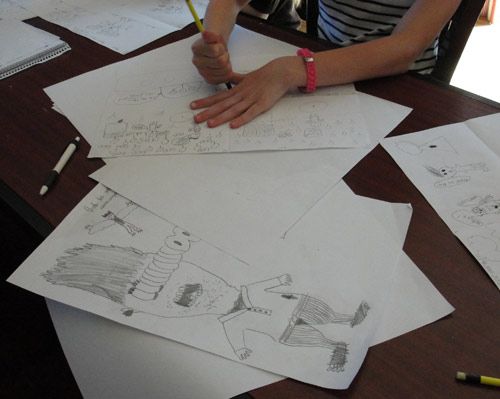
They had five minutes to draw a panel, then everyone passed their papers to the next person and for the next five minutes in the second panel, took up the new story where their neighbour had left off. 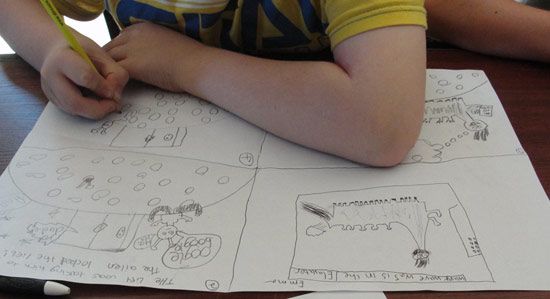
And so on, passing every five minutes until the four panels were filled.
At the end of 20 minutes, they had some great results. Here's one that made us laugh.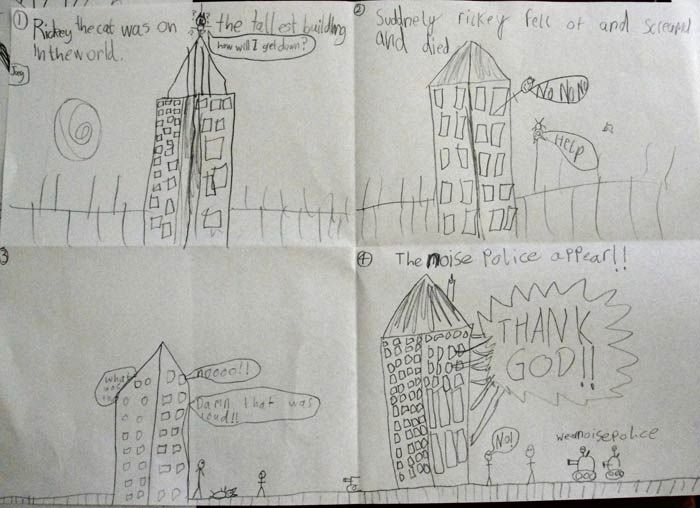
One of the cool things about doing events is meeting kids who are really stuck into comics already. Here's Finn, who brought along his notebook to show us and will obviously be an awesome comics artist if he keeps working as hard as he's doing now. 
I was thrilled to see he'd been studying my favourite comic strip, Calvin & Hobbes. Copying is a great way to learn in detail how another artist works, and I remember copying pages and pages of Archie comics when I was his age. 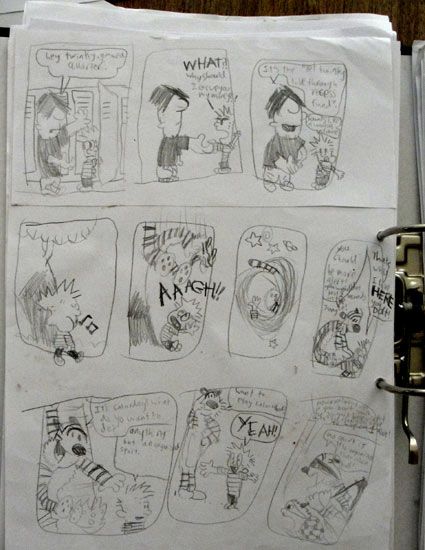
And he's coming up with great stuff of his own! Philip laughed and pointed out this Will-You-Need-a-Gas-Mask-o-Meter. 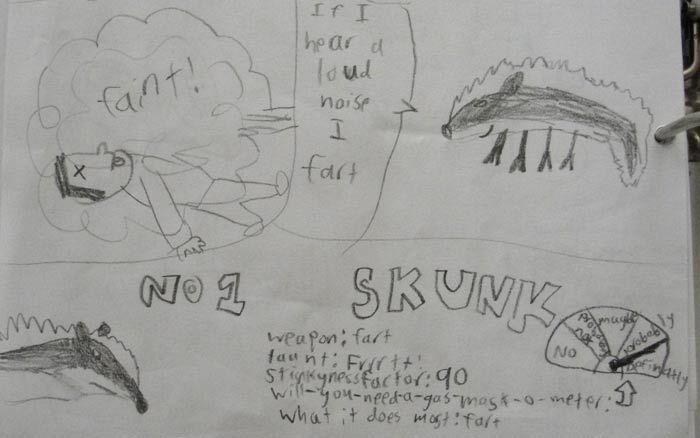
You can definitely see the influence of other comics on Finn's work, and it's great to see how he's exploring them and starting to add his own creative elements. Look out for this guy, he made be making appearances at small press comics fairs in the next few years. 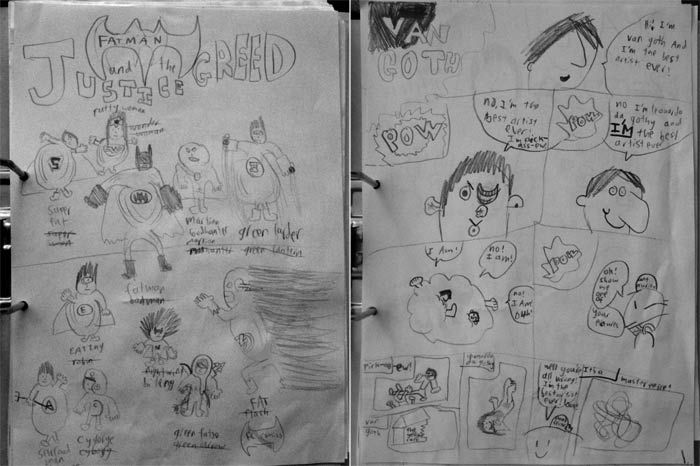
After our comics jam, we met up with lots of other writers on the yacht club deck to go for the Monster Book Lunch. I didn't get to talk with them as much as I would have liked to, but that's Claire Hennessey on the left (whom I hardly got to meet), someone (can anyone tell me who?) in the middle who I didn't really get to meet at all, and Judi Curtin, with whom I chatted briefly and is really lovely. Apparently her books are as popular in Ireland as Jacqueline Wilson's books are in England, so look out, English people, you might be seeing more of this lady. 
When I walked into the lovely banquet room, I was kind of expecting the table I was sharing with Philip Reeve to be packed with girls in tea party dresses. And most of the tables were like this, except ours, which was entirely seated with ROWDY BOYS. Ha ha! They were gentlemen enough to warn me not to drink the squash, which had salt and pepper added to it. 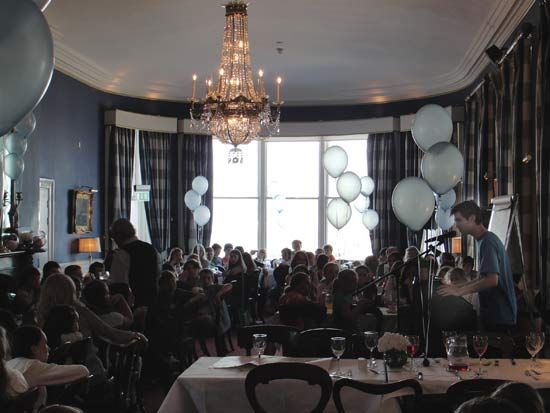
At most tables, the esteemed writers were having gracious conversations with their table mates, but that wasn't going to happen at ours. Instead we played a Monster Consequences game, and made some pretty awesome creatures. 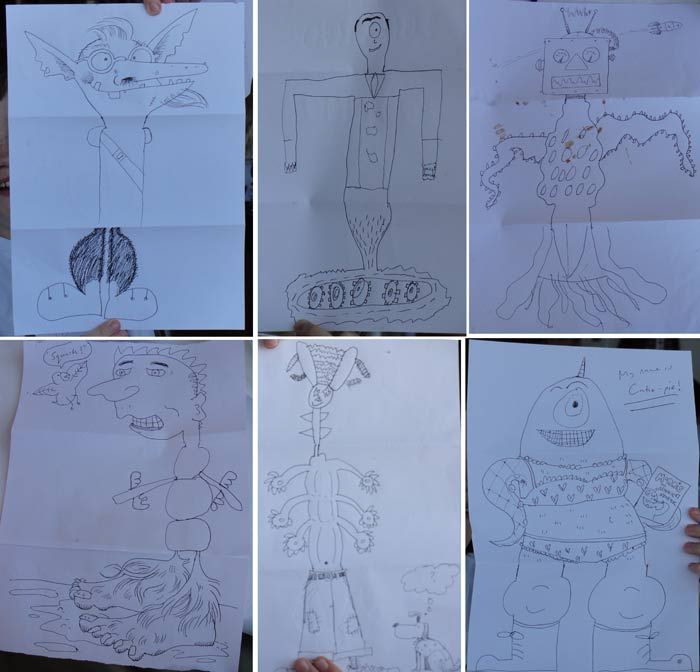
It was loads of fun meeting kids who already knew my work, including Shauna here, who was a huge fan and sent me a lovely e-mail which I read on my phone at the airport on the way home.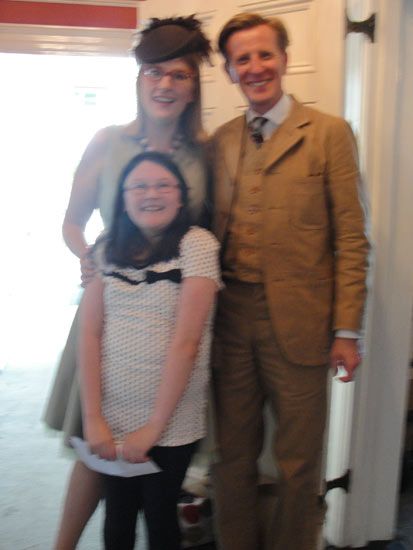
Here's our marvellous bookseller for the festival, the ever-energetic Bob Jonstone, who runs The Gutter Bookshop in Dublin's Temple Bar area. His shop's been getting lots of publicity and winning loads of awards recently, and he and his team ran the whole book sales side of things completely smoothly. Thanks, Bob! 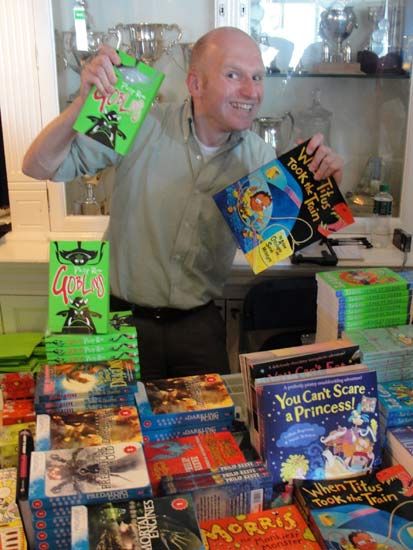
I left the Monster Book Lunch a bit early to do another Comics Jam workshop for older kids than the first one I'd done with Philip. Finn was there, but the rest were teenagers and a couple adults. They'd come to hear Steve Simpson give a talk on Superhero Illustration, but he had a family emergency, and the people at the workshop were great about letting me step in. Here are a couple of the Comics Jam results: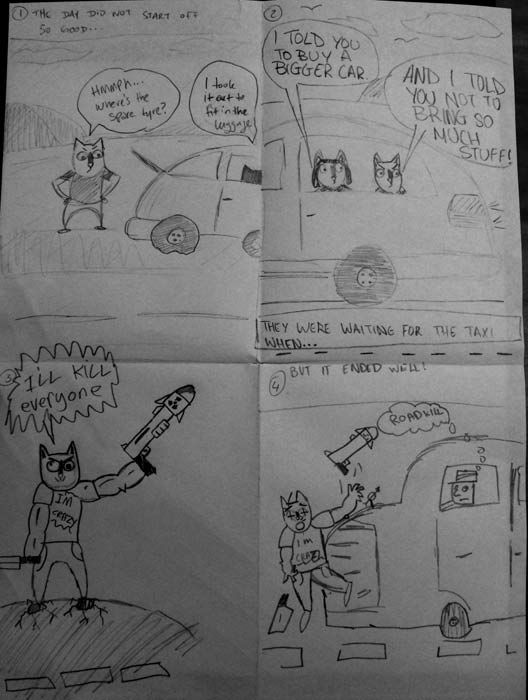

Meanwhile Philip Reeve was getting ready to go on a panel with writer Michelle Harrison, and I managed to dash in to listen, just as they were getting going. 
The panel was a project for the three girls interviewing Michelle and Philip. They'd had the chance to choose writers they'd like to interview, get them invited to the festival, and spend quite a lot of time preparing for the interview. They knew the writers' books well, and were able to ask some great questions. 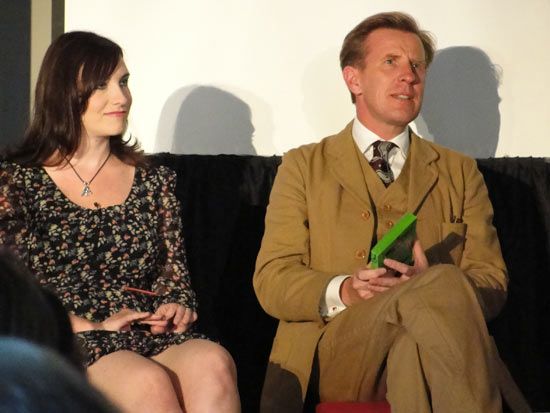
I was interested to find out that, like Philip, Michelle also does some illustration (as does Marcus Sedgwick, whom I mentioned earlier). And both she and Philip were very influenced by the early work of Brian Froud, who designed the looks for The Dark Crystal and Labyrinth films. Michelle writes a lot of horror stuff, and read from her recent book, Unrest, inspired by the sleep disorders she's encountered in people she knows. Here's the trailer video, and you can find out more over on her website.
Here's the fab panel, being VERY SCARED. 
Or is that speakers being VERY SCARY?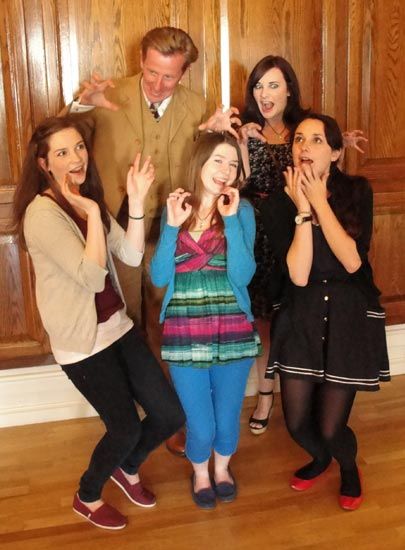
One of the great things about Mountains to Sea is that the festival's all within walking distance and everyone stays at the same place. So we were always bumping into people, including the writer Eoin Colfer (creator of Artemis Fowl), who wasn't even taking part in the festival this year! 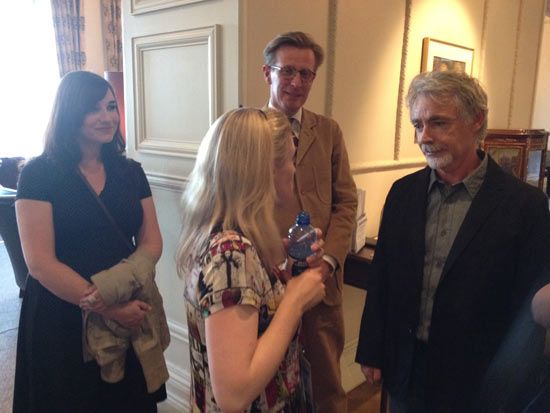
Here's the Royal Marine Hotel, a lovely Victorian candybox of a place: 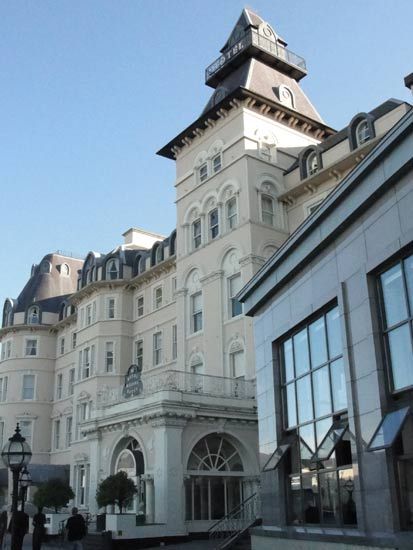
I got to sit across from Michelle at dinner, and meet writer Robert Muchamore. I didn't really know Robert's work, but he's the writer of the Cherub graphic novels, which my friend John Aggs illustrates, so it was great to meet him. Michelle (@MHarrison13) tweeted: Sat next to @RobertMuchamore at dinner earlier. He threw olives at me and pulled my hair. ...I think I will say nothing about that.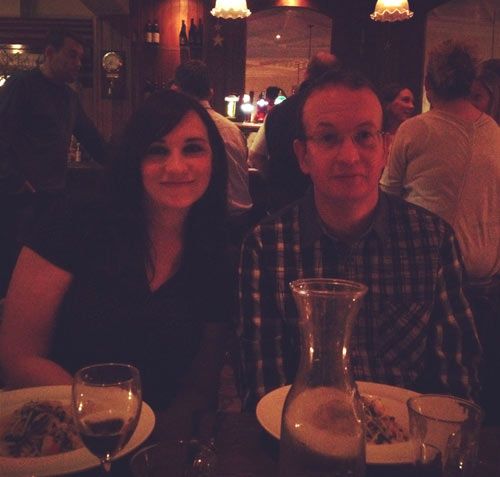
The next day, writer-illustrator Chris Judge and I went to the People's Park to take part in the Picture Book Picnic. I'd met Chris once before, at the festival at Tales on Moon Lane, but I'd been so busy keeping my group of kids from dumping paint on the bookshop floor that I didn't have much time to see him in action. 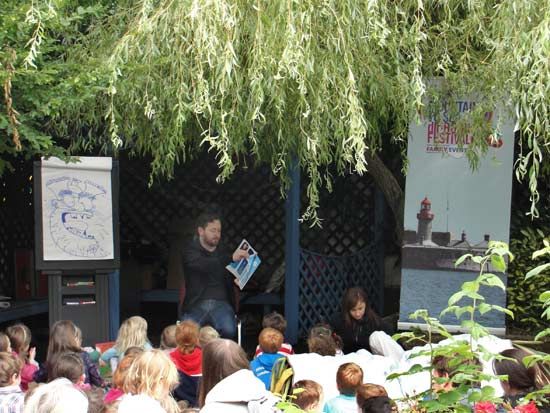
Here I am, reading from You Can't Scare a Princess. 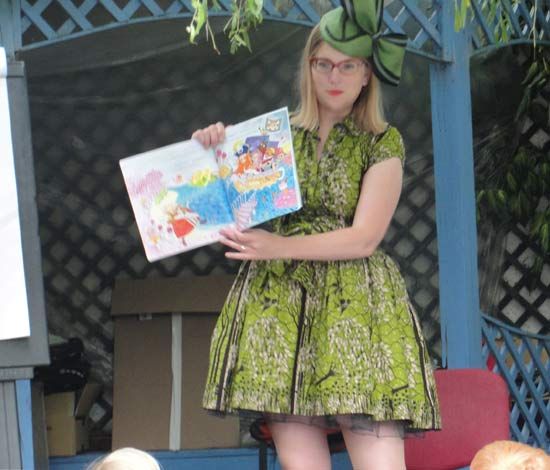
Chris did a great job reading from The Lonely Beast and The Great Explorer and getting the kids to respond. 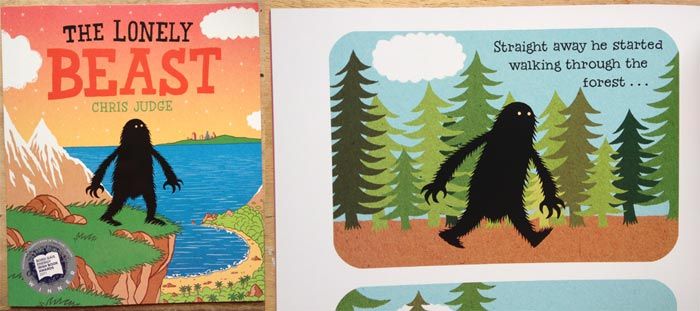
It was so obvious that all the kids, parents, festival volunteers, everyone, really love him. That's something so nice I'm noticing about Ireland. They don't have a huge home-grown publishing scene, but those they do have, they really get to know and cherish them. I really like that. 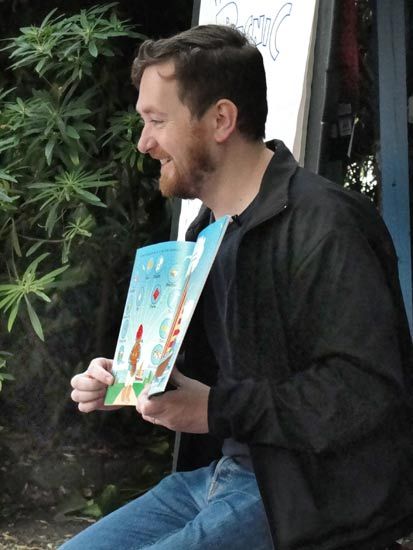
We both did some drawing with the kids. Here's Chris showing us how to draw the walrus from his book.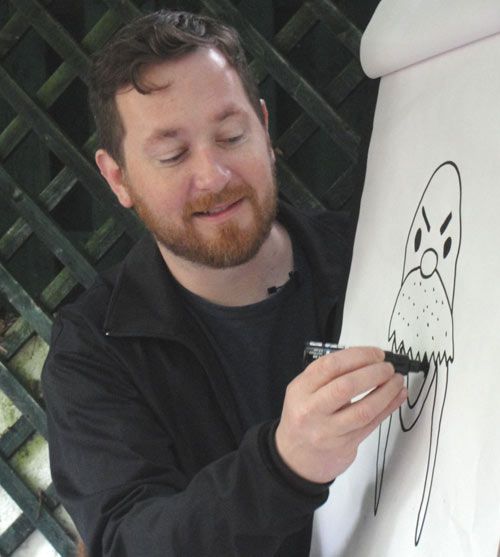
So many kids showed up that some of them had to share clip boards. I love this photo.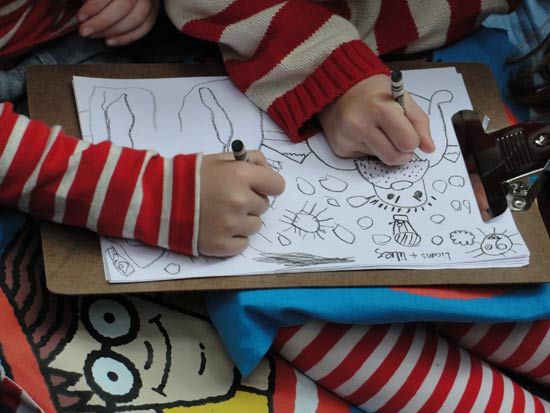
And this one, too. The team of volunteers was brilliant. And can I just say that if I was making an epic action film, I would want to cast this awesome-looking one in the lead role? This is designer-illustrator Simone Crowley and I spent some of the picnic admiring her and her tattoos from afar. 
And one more photo with Chris. The weeping willow in the Secret Garden section of the park made for a wonderfully atmospheric storybook kind of place. 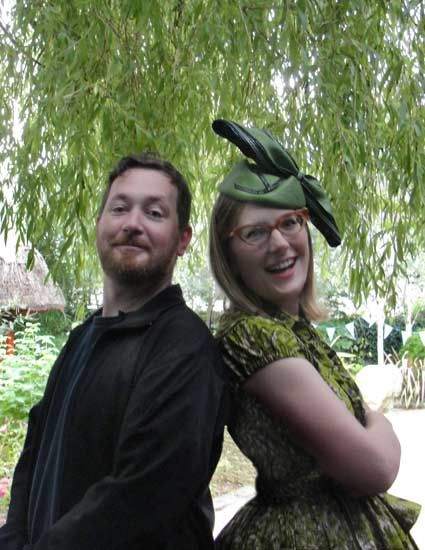
After the picnic, Tom and a lovely volunteer named Jenny hustled me off to County Hall for The Big Picture Panel Discussion with Chris, Inis magazine editor David Maybury and David Mackintosh. 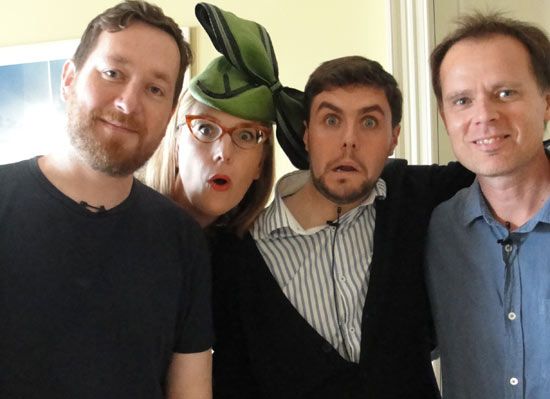
No event involving the whirlwind that is David Maybury can be anything other than terribly exciting, and this panel was no exception. The best part for me was finding out about David Mackintosh's work. I'd never even heard of him, but his books are SO beautiful. 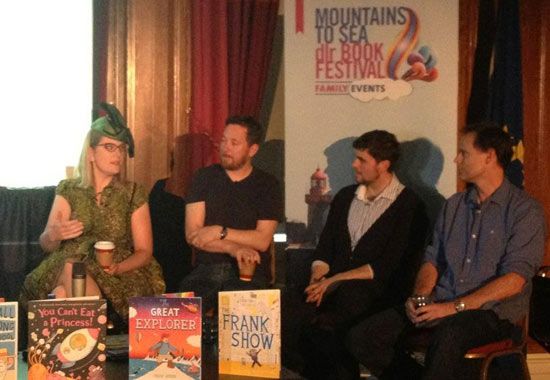
David's now London-based, but he was born in Belfast and grew up in Australia. And he worked as a graphic designer before moving into making his own picture books. And you can really tell: his understanding of typography, colour, how to use space on the page is exceptional. 
I'm already such a fangirl. Here's the dedication in one of the books I bought: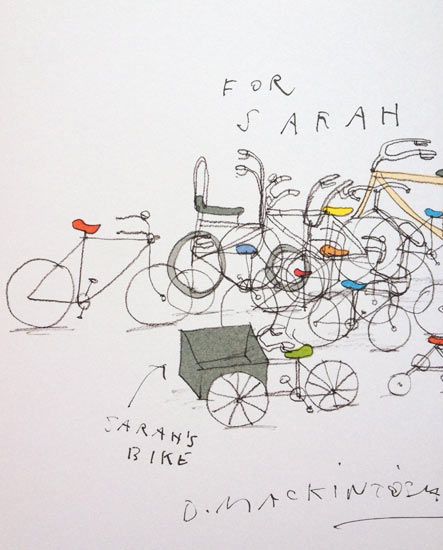
Aren't these pictures the best thing ever? 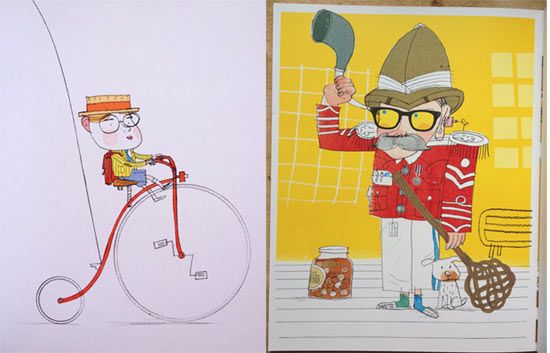
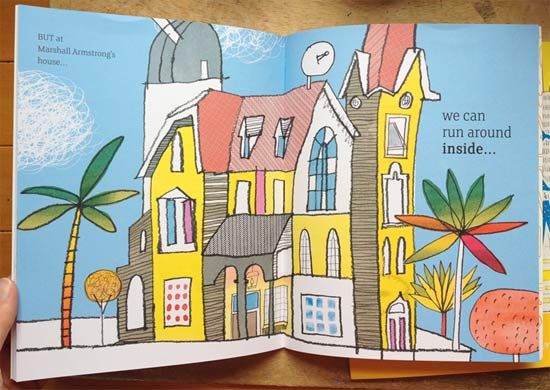
I talked a bit about self-publishing during the panel, and at the end, two members of the audience came up and gave me copies of their self-published books, The Enlightened Light Bulb Boy by Dublin-based Brazilian illustrator Tarsila Krüse and the Yum! Yum! Recipe Booklet by Tarsila and her friend Paula McGloin. 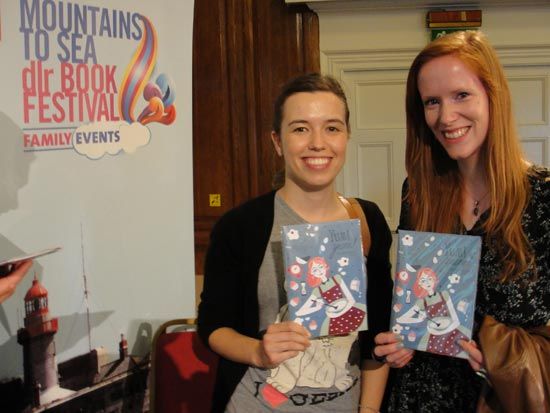
Googling their names, I saw their blog post about the annual Dublin Zine Fair, which looks like something worth visiting or taking part in if you're in town. 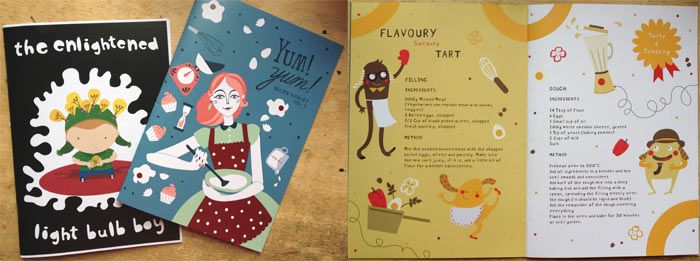
After the panel, CBI's Jenny Murray set me up for my interview for Inis magazine with Cethan Leahy, and we had a good chat.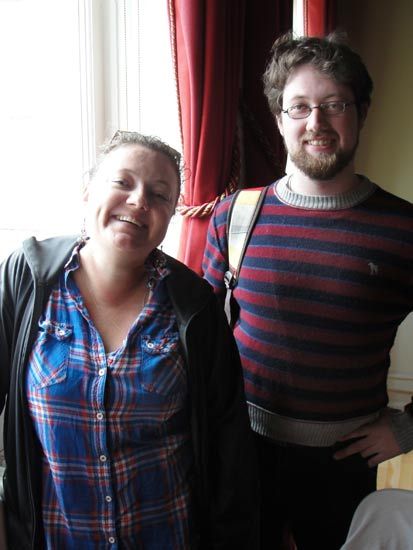
Then it was time to go home. Jenny whisked me off for a late lunch at the bagel place, then I got a festival taxi to the airport with Philip's agent, Philippa Milnes-Smith, and Sara Wingate Gray, who runs The Itinerant Poetry Library. Philippa and I listened, enthralled, to all the stuff Sara's been getting up to with her suitcase of poetry books, providing her 'guerilla public library service'. She was one of the first librarians to know about Twitter, which you can guess from her succinct Twitter name, @Librarian. I mentioned Audrey Niffenegger's graphic novel, The Night Bookmobile and short story Moths of the New World, and we decided that Sara had probably crawled out of the pages of one of those books before they were even written.
Oh, and this is my lovely new companion, a 'zonk' which I have named Webbster Donegan. She loves flying, even though her wings aren't terribly aerodynamic.
I was sad to leave. Someone tweeted a Dr Seuss quotation during the Paralympic Closing Ceremony that evening - 'Don't be sad it's over. Be glad it happened.' - and I thought that was a good way to look at it.
Goodbye, Ireland! An enormous thanks to Tom, Sarah, Marian, David, Jenny, Philip, CBI, Bob, Orla, the team of volunteers, and loads more people who made this festival such a wonderful experience. 
I feel like sleeping for a week now, and I'm sure the festival team do, too, but wow. That was amazing.
Blog: Sarah McIntyre (Login to Add to MyJacketFlap)
JacketFlap tags: ireland, dublin, Add a tag
Hey, look at the poster that just popped up on the Inis magazine blog!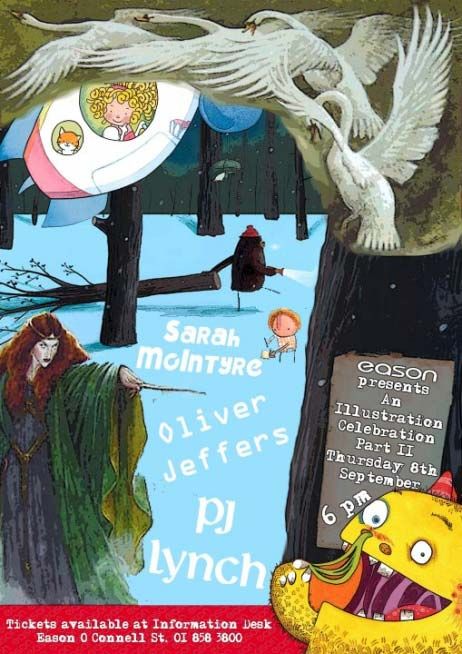
If you're anywhere near Dublin this Thursday, come join me and two top-notch illustrators Oliver Jeffers and PJ Lynch at the big Easons on O'Connell Street for a cosy evening event! I'm looking forward to finding out more about PJ Lynch and I'm already a huge fan of Oliver's work. I remember the first time I saw an original piece he'd done for The Incredible Book Eating Boy, I was totally blown away because none of it was digital (as I'd assumed), he'd really found all this beautiful old paper and things and cut and pasted and painted it together. 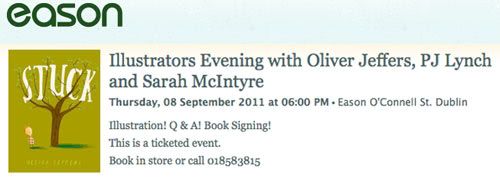
I've really enjoyed my trips to Ireland the past couple years (see past blog posts here). My studio mate, Gary Northfield and I did an amazing whistle-stop tour last year. You might have already seen this, but I'll post the video of our slot on RTE2 Irish kids telly, that was such good fun.
(Click here for Part 2)
Blog: Reading, writing, and chocolate (Login to Add to MyJacketFlap)
JacketFlap tags: dublin, trinity college, mcelderry, Add a tag
I shall enjoy getting used to saying it: "I'm a McElderry author."
Margaret K. McElderry Books, an imprint of Simon & Schuster, is going to publish my midgrade fantasy novel. The one I struggled to finish. And I can get used to saying this too: "My editor is the lovely Karen Wojtyla."
For all this loveliness, I owe untold thanks to my sweet and savvy (and lovely) agent Tracey Adams.
I also owe a small nod of gratitude to whatever magic resides in the campanile at Trinity College, Dublin:
I was lucky enough to visit in September, just after Tracey sent my manuscript out into the world. (Note to writers: I highly recommend a fun vacation to keep your mind off a manuscript sitting on editors' desks!)
Apparently, campus tradition says that it's bad luck to walk under the campanile if you're awaiting exam results, or other important news. So my husband made sure I walked around it. The rest of the tour group laughed. Little did they know!
The luck of the Irish? I believe!
(Hey! Isn't McElderry an Irish name....?)
Blog: OUPblog (Login to Add to MyJacketFlap)
JacketFlap tags: History, war, A-Featured, Easter, ireland, World History, The Rising, 1916, Dublin, Fearghal McGarry, Irish Republican Brotherhood, Sinn Fein, Add a tag
The Easter Rising of 1916 not only destroyed much of the center of Dublin – it changed the course of Irish history. Yet basic questions about why the event occurred continue to divide historians. In The Rising: Ireland: Easter 1916, by Fearghal McGarry, we learn about
the uprising from the perspective of those who made it. McGarry makes use of a collection of over 1,700 eye-witness statements detailing the political activities of members of Sinn Féin and militant groups such as the Irish Republican Brotherhood. In the excerpt below, we learn first-hand how it felt to walk off to war that morning.
The insurrection could not have begun in a more chaotic manner. Mobilizers received less than an hour’s notice to alert their companies, a process that normally took at least four hours. At 10 a.m. Liam Archer received an order to mobilize his section of the company – for 10 a.m.: “My first two calls at Jones Road and Clonliffe Road drew blanks, both members had gone out for the day. At this point the motor cycle combination broke down…I set off on foot for Blackhall Place, giving up the idea of mobilising my Section’. Seán Kennedy ‘only contacted those within reasonable walking distance’. John Kenny ignored the mobilization order he received, joining his friends on an outing as ‘we were still sore about the fiasco of the previous day’. The Third Battalion’s quartermaster told his mobilizer that he (like many other Volunteers and British army soldiers) was going to the Grand National horse race at Fairyhouse: ‘I said to him: “What will the battalion do, they are depending on you?” He said they would have to get a horse and car’. In contrast, more zealous Volunteers were delighted that the day had finally come. Annie Cooney recalled the excitement of Christy Byrne and Con Colbert, a former Chief Scout of the Fianna, who had devoted years of activism to bringing about an insurrection:
During the time I was buckling him up Con-who had not a note in his head-was singing ‘For Tone is coming back again’ he was so excited and charmed that at last the fight was coming off. He thought of nothing else. The pair went off, wheeling their bicycles which were loaded up with pikes, their rifles and small arms.
For many, the Rising was a family affair: fathers, brothers, sisters (and the occasional mother) fighting together. Michael O’Flanagan was mobilized with his father and two brothers, one of whom was killed. Molly Reynolds was joined by her father and three brothers. Some parents were prepared to sacrifice their children for the cause. Pat Fox thrust his young son-who was killed the following day-towards Frank Robbins as the rebels marched from Liberty Hall: ‘Here is my lad; take him with you for the Irish Citizen Army. I am too old for the job’. Some parents were willing to sacrifice themselves, leaving their children behind. After the Rising, John MacDonagh ‘was struck by the sight of a wife keeping step with her husband, Séamus Murphy, both prisoners. I knew both of them, and knew they had left their young children at home’. Some were motivated to fight because of their children, as one eld
Blog: Sarah McIntyre (Login to Add to MyJacketFlap)
JacketFlap tags: workshops, morris, dublin, Add a tag
Hello, please meet Manky Horace O'Neill, one of many monsters the kids in Dublin created with me.

I met a bunch of fab people at Irish 24 Hour Comics Day, including animator, illustrator and pop-up guru Maeve Clancy. You can see some of her amazing pop-up work on the video for Lisa Hannigan's song, Lille. (You can see a larger version at the Vimeo link and if that doesn't work, here's the YouTube link.)
Here's us watching the video (Maeve's the one in front of the laptop), and here's Cliodhna Lyons, who organised the whole thing! (She's wearing Hope Larson's Chiggers bandanna she got at MoCCA.)
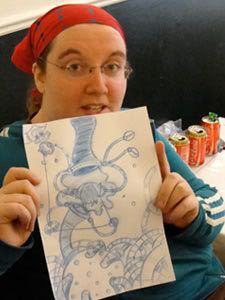
I was amazed how much detail some of the people were putting into their comics, considering they were going to be working at it for 24 hours on the trot. Here's one example from Eoin Marron:

I also got to meet Tsyuoshi Ogawa, the workshop leader Cliodhna had brought over from Japan, and who had been her working partner during their two-month internship at the Kyoto International Manga Museum. Here he is with his Australian translator from the museum, Cathy Sell. One fact about Tsyoshi is that he is totally obsessed with fishing, and he lit up when we went to a tackle shop in the city centre. Here he's posing with the shop's rather lovely sign, and the also very lovely fishing lures he bought: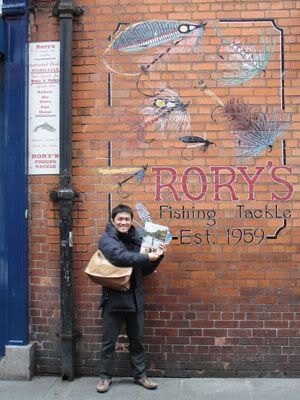

I led four monster workshops, which all went swimmingly. We had some fab (and very cheeky!) children make monsters with me at the Comics Day workshop. (Don't worry, I got permission from everyone's parents for the photos):
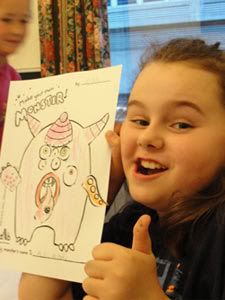
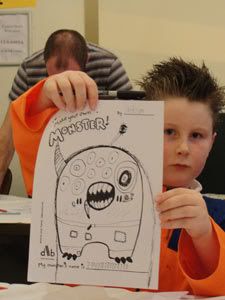
I must confess, I had a little difficulty with some of the Irish accents, although I think we all managed to understand each other in the end.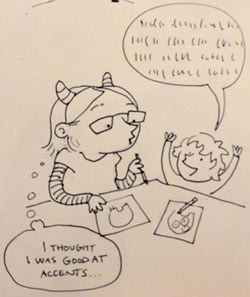
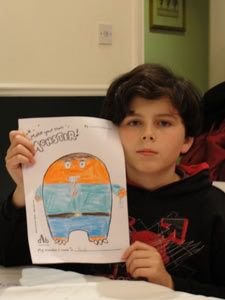
We sat around a little table in Waterstone's Jervis Street and had loads of kids stop by:

Dale O'Flaherty (![]() daleof) did the workshop with me, drawing great portaits of the kids and bookshop staff. Here's the manager, Steve, with his potrait:
daleof) did the workshop with me, drawing great portaits of the kids and bookshop staff. Here's the manager, Steve, with his potrait: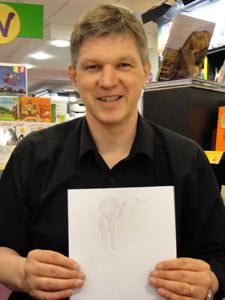
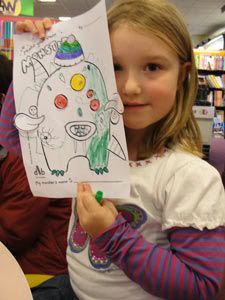

I didn't take any pictures of children at Eason's bookshop, but I promised them I'd post some of their pictures on my blog: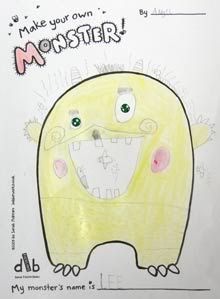



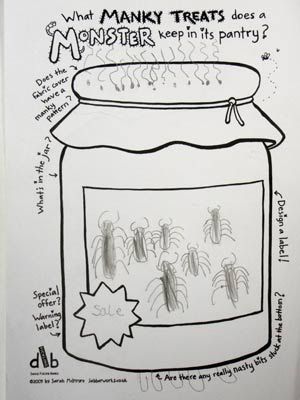
Here's Tom Donegan from Children's Books Ireland and Beata Molendowska from Dublin's Central Library.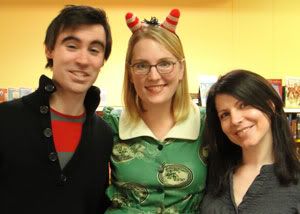
(You can see more photos and some of the drawings I did in Dublin on the post I did yesterday.)
Thanks for your support, everyone!
Blog: Neil Gaiman (Login to Add to MyJacketFlap)
JacketFlap tags: amanda palmer, Dublin, Neil Jordan, The Legion of Neils, Add a tag
Blog: Neil Gaiman (Login to Add to MyJacketFlap)
JacketFlap tags: cupcakes dammit, Cybil and me, art of Coraline, VIP airport magic, airports, early reviews of The Graveyard Book, Dublin, Add a tag

Originally, I was meant to get in to Dublin tomorrow, Sunday, and immediately start doing interviews. Somewhere mid-week I realised that simply wasn't going to work -- I'd burned the candle at both ends and incinerated the middle during the two weeks of Coraline-and-Newbery-Madness in the US, and flying to Dublin, getting off the plane and doing six print, one TV interview and then going to Dundrum to introduce the film and do a Q&A interview afterwards seemed like a recipe for disaster, or at least, for sleeping through my own film.
So everything moved a day earlier, and that was a good thing. The flight was easy and pleasant (I sat next to one of the Original Fathers of the Internet, and he wanted to know about writing and I wanted to know about The Internet, so we chatted cheerfully over the meal service, which almost never happens). On landing I was whisked magically from the jetway to a little VIP place where I was given a cup of tea and put in a car with a lady from Universal, and I dreamed that all international airport exits could be as smooth and as graceful and as queue-free.
My loverly Android G1 doesn't work here -- it was, as you may remember, a gift from Google, and is, until one day it won't be, free, but its very freeness meant that it won't connect to any foreign phone service, as someone would have to be billed for the connection. At the point it informed me that it was now just a thing with photos and music on, I discovered how much I miss it (memo to self, tapping on the screen of the Nokia N73 does nothing at all). My elderly and eccentric Nokia N73, which turns itself off from time to time a bit randomly, sometimes mid phone-call, is now my phone while I am in Ireland. And I discovered the problems I was having with its predictive text function could mostly be traced to fact that it had decided in the last month or so that it would rather predict words in Dutch.
Anyway. Happy Valentine's Day from someone in a suspiciously empty and unValentiny sort of Dublin hotel room.
The Graveyard Book won a Cybil Award -- which is the children's book award from the blogging community. I was thrilled. All of the Cybil nominees and winners looked good this year, and I'm proud to be among them, and congratulations to everyone involved.
Monica Edinger reviews The Graveyard Book at The New York Times. Her review finishes,
I read the last of “The Graveyard Book” to my class on a gloomy day. For close to an hour there were the sounds of only rain and story. In this novel of wonder, Neil Gaiman follows in the footsteps of long-ago storytellers, weaving a tale of unforgettable enchantment.Which made me really happy. The sounds of rain and story. Yes, that's what it's all for.
(About a month ago I'd told my Editor at HarperChildrens that I would send cupcakes for everyone at HarperChildrens if The Graveyard Book ever went back to Number One on the Childrens' list at the NYT. So last week, I sent an enormous number of cupcakes over to HarperChildren's [although ten percent of the cupcakes were paid for by my agent]. I've told them if we ever get to be Number One five weeks in a row, more cupcakes.)
Let's see.
Anyone who's seen CORALINE and wonders about the design work behind it should go and look at,
http://shaneprigmore.blogspot.com/
http://dankrall.blogspot.com/

They're all awesome artists, but Dan Krall's work actually made me wish that he'd actually illustrated an edition of Coraline. Anyway, go and look at their art: you'll see illustrations for scenes that didn't make it into the finished movie. Like the Dan Krall drawing above.
I really hope there will be an actual Art of Coraline book, to collect all of this stuff, along with the other things you can look at on the videos at http://thinkinganimationbook.blogspot.com/2009/02/coraline.html. At the time of Steve Jones's Coraline: A Visual Companion book (you can browse it here) Laika and Focus weren't able to provide anything much in the way of art as, they explained, very sensibly, they were madly trying to finish a movie (they even cancelled the book at one point, pointing out that they didn't have anyone available to go through the art, as everyone was working on the film, and it took Henry Selick's intervention to get them to provide stills and bring it back from the dead).
You want to know how to make 200,000 puppet-faces? You need a 3D printer.
Just wanna make a quick comment on Marcel's question, I watched Coraline yesterday here in Brazil and I watched it in 3D. Gotta say the dubbing is awesome. They're all great in what they do, really.
And it's, y'know, puppets.
Blog: Neil Gaiman (Login to Add to MyJacketFlap)
JacketFlap tags: Dublin, Add a tag
Hi Neil
I heard a rumour somewhere that you might be appearing at the Dublin Film Festival screening of Coraline. Is this true? Because it would be pretty awesome to have you there.
Eagerly anticipating respones
Jack
Yup. I'll be there. There will probably be an intro and a Q&A to go along with it.
(Amanda Palmer will be doing a gig at the Sugar Club in Dublin on the evening of the 16th.)
On the 17th, I'll be doing a signing/reading/singing from the WHO KILLED AMANDA PALMER book with special guest, Amanda Palmer (I will not be singing. She will,)at Chapters Bookshop on Parnell Street, at 5.00pm. (Or, if you are an Amanda Palmer/Dresden Dolls fan, Amanda Palmer will be doing a singing and signing with a special guest reader and signer of me on the 17th at 5.00pm.)
More soon. Off to airport for LA round two.
Blog: Neil Gaiman (Login to Add to MyJacketFlap)
JacketFlap tags: Coraline movie, Blueberry Girl, Dublin, Yes you could use the internet to figure out who I'm appearing with in Ireland but really now wouldn, Advertising and its drawbacks, Add a tag
The first Coraline trailer I've really liked. (It's up at YouTube in HD and is very cool.)
I don't know if you've heard this directly, but I know two people who, while being Gaiman fans, said independently of each other said, "I'm sick of this Coraline hype. Enough already."
While I'm eager to see the picture, I can understand what they perceive as advertising bombardments, be it billboards, web ads, commercials and so on.
I'm sure you would like as many people as possible to see the movie, do you think it's been "a bit much" with all the Coraline stuff out there?
Not really. It's a film without a big name star, handmade in Portland by a first time studio: it's not a film that the world is holding its breath for -- mostly, the world doesn't really even know it exists. The filmmakers have one crack at getting people in to see it on its first week of release, and only one, because, while it will undoubtedly go on to live forever on DVD format (and whatever comes after that), possibly even go on to Nightmare Before Christmas-like longevity, the perception of whether it was a success or a failure is mostly all about how it does when it goes out there on Feb 6th.
I'm proud of what Henry and his astonishing team did, and want as many people to see it as possible.
It's hard to promote a film that's as much for adults as it is for kids, easy for something like this to bomb -- or to be perceived as having bombed, which is not the same thing. The advertising is out there for another couple of weeks, and it'll probably get more pervasive as we get closer to the 6th of February, and will not please your friends. And the run up to Coraline will take over this blog more or less completely, I expect, because it's all I'll be doing. And then, after Feb 6th, it will all trail off, and the advertising will die away completely, and it will fade from the blog with occasional splashes of mention if the film does something interesting, or if I go somewhere to help promote it.
(Which reminds me: Jameson Dublin Film Festival. I'll be there on February the 15th, when they will be screening Coraline. And, for anyone in Dublin -- or indeed, in Ireland -- who missed the signing last year, I will be doing a reading and signing in Chapters in Parnell Street on Feb the 17th at 5pm. Perhaps with an as-yet-unnamed Special Musical Guest.)
...
I read This Blog of Cheryl Morgan's. Thought "That's bizarre. I mean no-one would actually DO that." Then read around and realised that, yes, there are people who are interpreting the laws to get lead out of products aimed at children as meaning that they have to be kept away from book, with all that printing in it. It's mad and silly, but here's an American Library Association letter explaining that, yes, it's true, and what you can do about it.
http://dintywrites.blogspot.com/2009/01/scary-library-shit.html
...

Lovely early BLUEBERRY GIRL reviews starting to come in:
Publishers Weekly
In a magical blessing for unconventional girls, Gaiman (The Graveyard Book) addresses the "ladies of light and ladies of darkness and ladies of never-you-mind," asking them to shelter and guide an infant girl as she grows. "Help her to help herself,/ help her to stand,/ help her to lose and to find./ Teach her we're only as big as our dreams./ Show her that fortune is blind." Sinuous, rococo lines-the flowing hair, drooping boughs, winding paths that inspired the pre-Raphaelites-spread their tendrils throughout Vess's (The Ladies of Grace Adieu) full-bleed spreads, potent mixtures of the charms of Arthur Rackham, Maxfield Parrish and Cecily Barker's flower fairies. An Art Nouveau-ish font in a blueberry color compounds the sense of fantasy. On each page a different girl-short, tall, white, brown, younger, older-runs or jumps or swims, accompanied by animals meant to guard and protect her. Fans of Gaiman and Vess will pounce on this creation; so too will readers who seek for their daughters affirmation that sidesteps traditional spiritual conventions. All ages. (Mar.)
Kirkus Reviews
A rich and beautiful prayer for a girl. "Ladies of light and ladies of darkness and ladies of never-you-mind, / This is a prayer for a blueberry girl." Three women in flowing robes-the appropriately mythological Maiden, Mother and Crone-float in the sky over a small, dancing child trailed by numerous birds of the air. Free her from "nightmares at three or bad husbands at thirty," let her run and dance and grow, teach her and help her find her own truth. The verse is lovely, sinuous and sweetly rhyming, piling on blessings. Vess's precise line-and-color illustrations fill each spread with velvet colors and the iconography of myths and fairy tales, a good match to fantasist Gaiman's words. Plants, animals, sun and meadow appear in elegantly drawn detail, their realism tempered by floating trees and magical flowers. The girl transforms from stanza to stanza and spread to spread, blond or burnished, child or nearly teen. There is nothing cute or cloying here, just beauty, balance and joy. (Picture book. 4-8)
The only Blueberry Girl event will be on Saturday March 7th, at Books of Wonder in New York. Me and Charles Vess, signing books for anyone who comes by, along with a display of the original paintings, a Q&A, and so on. If you're in New York, we'd love to see you -- more details as I get them.
Blog: librarian.net (Login to Add to MyJacketFlap)
JacketFlap tags: librarian, librarians, ireland, dublin, onit, Add a tag
I am a sucker for these sweet obituaries of librarians. Máirín O’Byrne not only beefed up the libraries in Dublin city and county, she was very professionally active and provided home and hearth to many members of her family who were also involved in good works. We should all be so lucky to be so fondly remembered. [thanks eoin]




Incredible effort, I do hope the third sibling helped out with those parents (can’t expect priests to do that, you know.) What a great story, thanks, J.